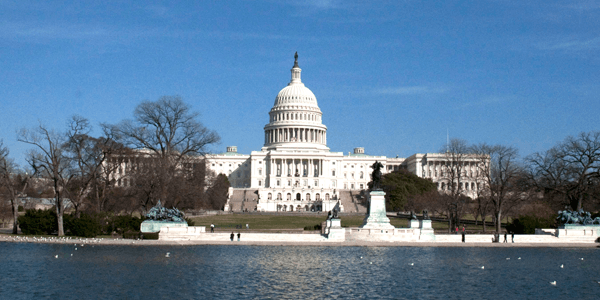Thursday April 18, 2024
Washington News

Protect Yourself from Phishing Emails
During the holiday season, fraudsters are likely to send many phishing emails. Billions of phishing emails are sent each year because they work well for identity thieves. The average person receives a significant number of emails each day and may not take the time to examine an email. Fortunately, protecting yourself from emails is a learned skill and can be easily accomplished.
First, you should be alert and use sound judgement to check each email. Are you familiar with the sender? Is the content you would expect from that person? Do they regularly send information to you? These are good questions to ask. It is especially important to review the email if it claims to come from your bank, a certified financial planner (CFP) or certified public accountant (CPA). Many fraudsters have been successful by impersonating the Internal Revenue Service (IRS), another government agency or your credit card company. For example, you may be asked to click on a link to resolve an immediate problem with a charge on your credit card. These types of emails should immediately raise red flags and require further exploration before clicking any links or entering personal information.
Many phishing emails can generally be identified because of the abnormalities in the text. Emails from fraudsters that are overseas often have typographical errors. There may be names that are misspelled or do not fit the organization. Some emails may use a name that is similar to your bank, financial service company or your professional tax advisor, but it is not exactly correct. Phishing emails may claim to come from financial organizations you regularly work with but may lack the logo or other identifying information. If there is anything unusual about the email, it is much more likely that it is a phishing email.
A primary solution is to not click on a link, but to contact the sender directly, not as a reply to the suspicious email. For a bank or credit card issue, there is a public access phone number for the bank or a phone number listed on the reverse side of your credit or debit card. Call the official phone number for the bank or credit card company to discuss the claimed problem. You may be able to review the sender’s email address in the header to also verify you recognize it. However, by simply calling the claimed sender, you can confirm whether or not this email is legitimate. If you do know the claimed sender of the email, you might send a new email to the purported person to ask if the suspicious email address is a correct email.
You can quickly determine whether a link is legitimate to a bank, financial institution or other organization by hovering with your cursor over the link, but do not click on it. The hovering will allow you to review the address link. If it is a short link or strange email address, it is likely that the link is to a fraudster's website. Do not click on that link as doing so could load malware on your computer.
The holiday season is a prime time for fraudsters to try to collect access to your accounts and personal information. Scammers plan to steal your information and file a tax return in late January or early February so that their tax return arrives first at the IRS and the fraudulent refund will be sent to them.
Email is now a common fact of life, even for seniors. The Pew Research Organization estimates that 75% of individuals aged 75 and above now use email. Because fraudsters are becoming more clever each year, everyone needs to understand how to exercise best practices, common sense and basic exploration methods to find, identify and delete phishing emails.
In Announcement 2022-28; 2022-52 IRB 1, the Internal Revenue Service (IRS) announced that it published proposed regulations (REG-106134-22) that require identifying certain syndicated conservation easement transactions as listed transactions.
The proposed regulations are a response to a Tax Court decision in Green Valley Investors LLC v. Commissioner, 159 T.C. No. 5 (2022) that invalidated Notice 2017-10. This was followed with a Sixth Circuit opinion, Mann Construction, Inc. v. United States, 27 F.4th, 1138 (6th Cir. 2022) that invalidated Notice 2007-83. The courts determined that the IRS had not followed the required rulemaking and comment procedure specified by the Administrative Procedure Act (APA).
As a result, the IRS stated, "Accordingly, to avoid confusion and to prevent disruption of the IRS's ongoing efforts to identify and examine abusive tax shelters throughout the nation, the Treasury Department and the IRS are issuing the proposed regulations to identify certain syndicated conservation easement transactions as listed transactions." The proposed regulations indicate that syndicated conservation easement partnerships will be listed transactions if they meet certain parameters. There are four basic elements in Prop. Reg. 1.6011-9(b).
First, the taxpayer must receive promotional materials that promise a charitable contribution deduction that is at least 2.5 times the investment. The materials may be "marketing materials, appraisals (including preliminary appraisals, draft appraisals, and the appraisal that is attached to the taxpayer's return), websites, transactional documents such as the deed of conveyance, private placement memoranda, tax opinions, operating agreements, subscription agreements, statements of the anticipated value of the conservation easement, and statements of the anticipated amount of the charitable contribution deduction."
Second, the taxpayer must acquire an interest in one or more tiers of the pass-through entity, directly or indirectly. Third, the pass-through entity contributes an easement on real property to a qualified organization and allocates a charitable contribution deduction to the taxpayer. Finally, the taxpayer reports on his or her federal income tax return a charitable contribution deduction for the conservation easement.
Commentators have noted that there are multiple ways promoters try to avoid the 2.5 times rule. Therefore, there are three specific rules intended to reduce abuse. First, if a promoter gives a range of potential deductions, the highest deduction amount quoted will apply. Second, there is a rebuttable presumption that the 2.5 times rule is met if the conservation easement is donated within three years following the investment, the charitable donation equals or exceeds 2.5 times the investment, and the taxpayer claims a deduction 2.5 times the amount of the investment or more. The presumption may be rebutted if the taxpayer convinces the IRS that there were no promotional materials that promised the 2.5 times deduction. Finally, there is an "anti-stuffing" rule. The 2.5 times rule is limited to the investment in the real property on which a conservation easement is placed. Other investments of cash, other real property, digital assets, marketable securities or other assets will not be applicable to the 2.5 times inquiry.
Material advisers also have disclosure requirements. A material advisor directly or indirectly derives gross income for the provision of aid, assistance or advice with respect to the listed transaction.
Generally, qualified organizations have not been treated as a party to the transaction under Section 4965. However, disclosures under Notice 2017-10 revealed that some nonprofits have facilitated abusive syndicated conservation easements. The IRS stated, "These disclosures indicate that a small number of qualified organizations facilitate abusive syndicated conservation easement transactions, sometimes for several hundreds of investors per year."
The IRS recognizes that many land trusts are not willing to participate in these syndicated conservation easement transactions if the appraisal value is more than 2.5 times the basis or there is a sale within 36 months of the acquisition of the property. However, the IRS determined that Section 4965 would apply to nonprofits and they could be subject to the $20,000 tax imposed by Section 4965(a)(2). However, the Treasury Secretary is permitted to exclude certain nonprofits from this provision.
Listed transaction participants who fail to disclose are subject to penalties under Section 6707A. There also is an extended period of limitations under Section 6501(c)(10). These disclosure requirements apply to material advisers.
A nonprofit has filed a complaint in the U.S. District Court of the Southern District of Ohio, The Buckeye Institute v. IRS et al.; No. 2:22-cv-04297, requesting injunctive relief to avoid disclosure of major donors on IRS Form 990.
The Buckeye Institute is an organization that engages in various types of advocacy. It claimed that "This compelled disclosure regime, disconnected from any identifiable need for the information it gathers and then leaves at risk of public disclosure, violates the First Amendment rights of association and assembly of Buckeye and its supporters, both on its face and as applied."
Buckeye notes that tax returns are private under federal law. However, there have been at least 14 cases where the IRS failed to protect the privacy of donors. Donors to political advocacy groups are especially sensitive to the disclosure of their gift amounts. The fear that the IRS may disclose donor names and gifts could reduce support for the Buckeye Institute and other advocacy organizations.
In Americans for Prosperity Foundation v. Bonta, 141 S. Ct. 2373 (2021), the Supreme Court determined that California would be barred from collecting unredacted copies of IRS Schedule B from Forms 990. Collecting donor names was determined to be unnecessary for state regulation and could lead to inadvertent disclosure of confidential taxpayer information. Buckeye noted that the Schedule B donor disclosure requirement was also removed for other nonprofits, with the exception of those exempt under Section 501(c)(3). It notes that if the disclosure is not needed for other nonprofits, then there should be consistency in the tax law and disclosure should no longer be required for Sec. 501(c)(3) nonprofits.
The current Section 507(d)(2)(A) requirement is disclosure of the name of individuals who give more than $5,000 in one year if it is an amount greater than 2% of total contributions. If the tax-exempt organization fails to include complete information, including donor names and gift amounts in Schedule B of Form 990, there may be penalties up to $10,000 or 5% of the organization's gross receipts. Section 6652(c)(1)(A).
Therefore, Buckeye requests that the IRS remove the donor disclosure requirement for Sec. 510(c)(3) nonprofits.
The IRS has announced the Applicable Federal Rate (AFR) for December of 2022. The AFR under Section 7520 for the month of December is 5.2%. The rates for November of 4.8% or October of 4.0% also may be used. The highest AFR is beneficial for charitable deductions of remainder interests. The lowest AFR is best for lead trusts and life estate reserved agreements. With a gift annuity, if the annuitant desires greater tax-free payments the lowest AFR is preferable. During 2022, pooled income funds in existence less than three tax years must use a 1.6% deemed rate of return.
First, you should be alert and use sound judgement to check each email. Are you familiar with the sender? Is the content you would expect from that person? Do they regularly send information to you? These are good questions to ask. It is especially important to review the email if it claims to come from your bank, a certified financial planner (CFP) or certified public accountant (CPA). Many fraudsters have been successful by impersonating the Internal Revenue Service (IRS), another government agency or your credit card company. For example, you may be asked to click on a link to resolve an immediate problem with a charge on your credit card. These types of emails should immediately raise red flags and require further exploration before clicking any links or entering personal information.
Many phishing emails can generally be identified because of the abnormalities in the text. Emails from fraudsters that are overseas often have typographical errors. There may be names that are misspelled or do not fit the organization. Some emails may use a name that is similar to your bank, financial service company or your professional tax advisor, but it is not exactly correct. Phishing emails may claim to come from financial organizations you regularly work with but may lack the logo or other identifying information. If there is anything unusual about the email, it is much more likely that it is a phishing email.
A primary solution is to not click on a link, but to contact the sender directly, not as a reply to the suspicious email. For a bank or credit card issue, there is a public access phone number for the bank or a phone number listed on the reverse side of your credit or debit card. Call the official phone number for the bank or credit card company to discuss the claimed problem. You may be able to review the sender’s email address in the header to also verify you recognize it. However, by simply calling the claimed sender, you can confirm whether or not this email is legitimate. If you do know the claimed sender of the email, you might send a new email to the purported person to ask if the suspicious email address is a correct email.
You can quickly determine whether a link is legitimate to a bank, financial institution or other organization by hovering with your cursor over the link, but do not click on it. The hovering will allow you to review the address link. If it is a short link or strange email address, it is likely that the link is to a fraudster's website. Do not click on that link as doing so could load malware on your computer.
The holiday season is a prime time for fraudsters to try to collect access to your accounts and personal information. Scammers plan to steal your information and file a tax return in late January or early February so that their tax return arrives first at the IRS and the fraudulent refund will be sent to them.
Email is now a common fact of life, even for seniors. The Pew Research Organization estimates that 75% of individuals aged 75 and above now use email. Because fraudsters are becoming more clever each year, everyone needs to understand how to exercise best practices, common sense and basic exploration methods to find, identify and delete phishing emails.
IRS Releases Proposed Syndicated Easement Listing Regulations
In Announcement 2022-28; 2022-52 IRB 1, the Internal Revenue Service (IRS) announced that it published proposed regulations (REG-106134-22) that require identifying certain syndicated conservation easement transactions as listed transactions.
The proposed regulations are a response to a Tax Court decision in Green Valley Investors LLC v. Commissioner, 159 T.C. No. 5 (2022) that invalidated Notice 2017-10. This was followed with a Sixth Circuit opinion, Mann Construction, Inc. v. United States, 27 F.4th, 1138 (6th Cir. 2022) that invalidated Notice 2007-83. The courts determined that the IRS had not followed the required rulemaking and comment procedure specified by the Administrative Procedure Act (APA).
As a result, the IRS stated, "Accordingly, to avoid confusion and to prevent disruption of the IRS's ongoing efforts to identify and examine abusive tax shelters throughout the nation, the Treasury Department and the IRS are issuing the proposed regulations to identify certain syndicated conservation easement transactions as listed transactions." The proposed regulations indicate that syndicated conservation easement partnerships will be listed transactions if they meet certain parameters. There are four basic elements in Prop. Reg. 1.6011-9(b).
First, the taxpayer must receive promotional materials that promise a charitable contribution deduction that is at least 2.5 times the investment. The materials may be "marketing materials, appraisals (including preliminary appraisals, draft appraisals, and the appraisal that is attached to the taxpayer's return), websites, transactional documents such as the deed of conveyance, private placement memoranda, tax opinions, operating agreements, subscription agreements, statements of the anticipated value of the conservation easement, and statements of the anticipated amount of the charitable contribution deduction."
Second, the taxpayer must acquire an interest in one or more tiers of the pass-through entity, directly or indirectly. Third, the pass-through entity contributes an easement on real property to a qualified organization and allocates a charitable contribution deduction to the taxpayer. Finally, the taxpayer reports on his or her federal income tax return a charitable contribution deduction for the conservation easement.
Commentators have noted that there are multiple ways promoters try to avoid the 2.5 times rule. Therefore, there are three specific rules intended to reduce abuse. First, if a promoter gives a range of potential deductions, the highest deduction amount quoted will apply. Second, there is a rebuttable presumption that the 2.5 times rule is met if the conservation easement is donated within three years following the investment, the charitable donation equals or exceeds 2.5 times the investment, and the taxpayer claims a deduction 2.5 times the amount of the investment or more. The presumption may be rebutted if the taxpayer convinces the IRS that there were no promotional materials that promised the 2.5 times deduction. Finally, there is an "anti-stuffing" rule. The 2.5 times rule is limited to the investment in the real property on which a conservation easement is placed. Other investments of cash, other real property, digital assets, marketable securities or other assets will not be applicable to the 2.5 times inquiry.
Material advisers also have disclosure requirements. A material advisor directly or indirectly derives gross income for the provision of aid, assistance or advice with respect to the listed transaction.
Generally, qualified organizations have not been treated as a party to the transaction under Section 4965. However, disclosures under Notice 2017-10 revealed that some nonprofits have facilitated abusive syndicated conservation easements. The IRS stated, "These disclosures indicate that a small number of qualified organizations facilitate abusive syndicated conservation easement transactions, sometimes for several hundreds of investors per year."
The IRS recognizes that many land trusts are not willing to participate in these syndicated conservation easement transactions if the appraisal value is more than 2.5 times the basis or there is a sale within 36 months of the acquisition of the property. However, the IRS determined that Section 4965 would apply to nonprofits and they could be subject to the $20,000 tax imposed by Section 4965(a)(2). However, the Treasury Secretary is permitted to exclude certain nonprofits from this provision.
Listed transaction participants who fail to disclose are subject to penalties under Section 6707A. There also is an extended period of limitations under Section 6501(c)(10). These disclosure requirements apply to material advisers.
Nonprofit Opposes Major Donor Disclosure
A nonprofit has filed a complaint in the U.S. District Court of the Southern District of Ohio, The Buckeye Institute v. IRS et al.; No. 2:22-cv-04297, requesting injunctive relief to avoid disclosure of major donors on IRS Form 990.
The Buckeye Institute is an organization that engages in various types of advocacy. It claimed that "This compelled disclosure regime, disconnected from any identifiable need for the information it gathers and then leaves at risk of public disclosure, violates the First Amendment rights of association and assembly of Buckeye and its supporters, both on its face and as applied."
Buckeye notes that tax returns are private under federal law. However, there have been at least 14 cases where the IRS failed to protect the privacy of donors. Donors to political advocacy groups are especially sensitive to the disclosure of their gift amounts. The fear that the IRS may disclose donor names and gifts could reduce support for the Buckeye Institute and other advocacy organizations.
In Americans for Prosperity Foundation v. Bonta, 141 S. Ct. 2373 (2021), the Supreme Court determined that California would be barred from collecting unredacted copies of IRS Schedule B from Forms 990. Collecting donor names was determined to be unnecessary for state regulation and could lead to inadvertent disclosure of confidential taxpayer information. Buckeye noted that the Schedule B donor disclosure requirement was also removed for other nonprofits, with the exception of those exempt under Section 501(c)(3). It notes that if the disclosure is not needed for other nonprofits, then there should be consistency in the tax law and disclosure should no longer be required for Sec. 501(c)(3) nonprofits.
The current Section 507(d)(2)(A) requirement is disclosure of the name of individuals who give more than $5,000 in one year if it is an amount greater than 2% of total contributions. If the tax-exempt organization fails to include complete information, including donor names and gift amounts in Schedule B of Form 990, there may be penalties up to $10,000 or 5% of the organization's gross receipts. Section 6652(c)(1)(A).
Therefore, Buckeye requests that the IRS remove the donor disclosure requirement for Sec. 510(c)(3) nonprofits.
Applicable Federal Rate of 5.2% for December -- Rev. Rul. 2022-22; 2022-49 IRB 1 (15 November 2022)
The IRS has announced the Applicable Federal Rate (AFR) for December of 2022. The AFR under Section 7520 for the month of December is 5.2%. The rates for November of 4.8% or October of 4.0% also may be used. The highest AFR is beneficial for charitable deductions of remainder interests. The lowest AFR is best for lead trusts and life estate reserved agreements. With a gift annuity, if the annuitant desires greater tax-free payments the lowest AFR is preferable. During 2022, pooled income funds in existence less than three tax years must use a 1.6% deemed rate of return.
Published December 9, 2022
Previous Articles
Benefit in 2022 With an IRA Charitable Rollover
IRA Required Minimum Distributions by December 31






